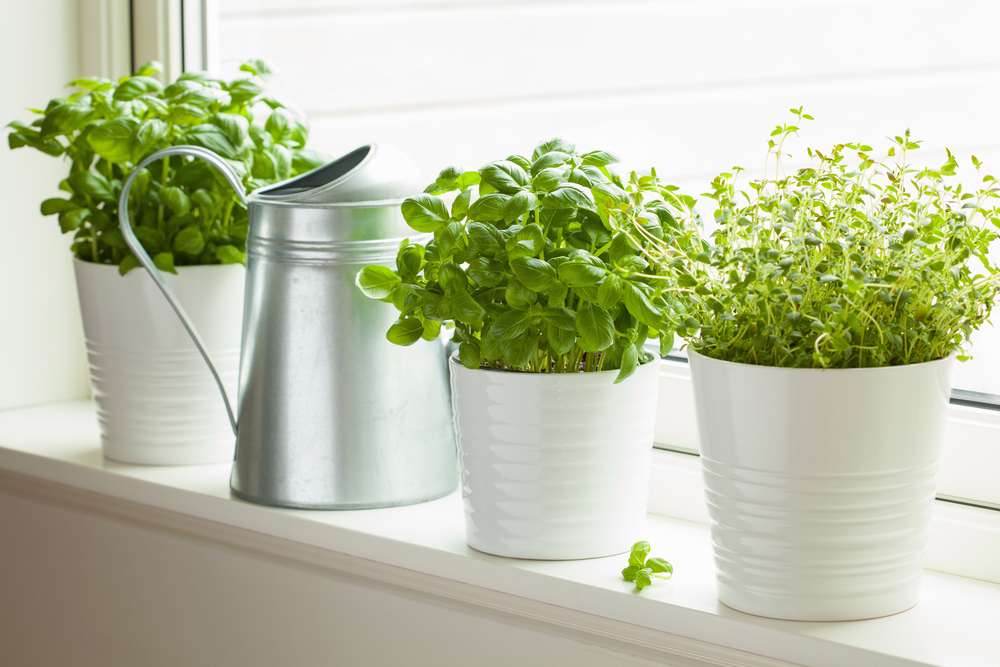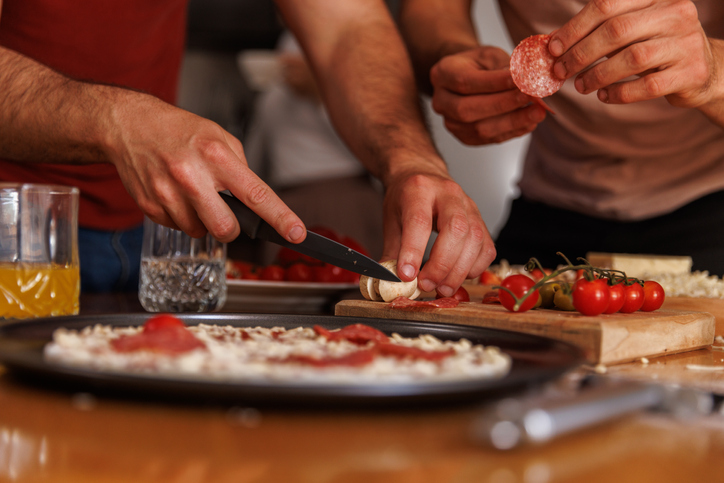How to Grow Herbs in Your Kitchen!

Is it okay to grow herbs in your kitchen? Yes! Growing herbs in your kitchen is legal, cool, and delicious—we recommend it! If you’ve ever compared fresh herbs to their dried format, you’ll already know fresh herbs are about a million times better, and growing them yourself is more than worth it.
Besides the incentive of having fresh herbs to add to any recipe you make, a kitchen herb garden can also be a fulfilling hobby!
Grow the Best Herbs
Keeping an indoor garden is one of the easiest types of gardens to keep. Think about it: if your garden is inside, you can fully control the environment! To make sure your herbs will grow to the peak of deliciousness, focus on getting them all the essentials they need.
Sunlight
Herbs need at least 6 hours of full sun every day. Keeping them near a south-facing window is best, but if your house doesn’t get that much sunlight, consider purchasing a grow light to supplement the lack of sun.
Water
Herbs should be watered once the soil feels dry when you touch it. This is pretty simple. Don’t overthink it.
Nutrients
Use a water-soluble fertilizer with lots of nitrogen. This will help your herbs grow healthy leaves more quickly.
Temperature and Humidity
Herbs grow better when the air is wetter! Use a mister or humidifier to keep them happy, especially during the colder, dryer months. The ideal temperature for growing herbs is between 65 to 70 degrees during the day with nighttime temps no lower than 55 degrees.
Plan Ahead
The best time to start growing herbs in your kitchen is several weeks before you want to start harvesting fresh herbs in your kitchen. If you’re already past that point, there’s no time like the present! The end of summer or beginning of fall is perfect, especially if you’re going to relocate cuttings from your own outdoor herb garden—or adopt cuttings from friends or family. If you’re growing herbs from seeds, expect to be able to begin harvesting within a few weeks.
Also consider where in your house you’ll be keeping your indoor herbs growing. While the idea is to grow herbs in your kitchen, that might not be the most ideal space for a variety of reasons. If this is the case, consider keeping “doubles” of all your herbs: one set in the kitchen for harvesting and another set in a room with better growing conditions. Swap them back and forth every week or so and you’ll always have fresh herbs handy when you need them!
Collect Your Supplies
When you’re choosing herbs and picking out supplies, just make sure to have everything else before you have a collection of herbs that need planting!
Planting Pots
While there are tons and tons of sets of teeny, tiny, miniature aesthetic plant pots, we suggest you get ones that are just a bit bigger than you think you’ll need. If you do this right, the herbs will grow a lot and they’ll outgrow the mini planters.
Pot Trays
These are the little saucers that sit underneath the plant pots to keep water from spilling as it drains through the soil and roots. It’s super easy to forget about these if they don’t come with the plant pots you got. Do not forget the pot trays (you’ll regret it when you water your herbs for the first time).
Potting Soil
When you’re getting soil to plant your herbs, make sure you get potting soil. If you can find one specially mixed for growing herbs or similar garden plants, all the better.
Seeds, Seedlings, or Rooted Cuttings
Choosing which herbs to grow in your kitchen mostly comes down to personal taste and the size of the herbs. If the herbs are bushy, tree-like, tend to be big or grow in unpredictable ways, they’re not well-suited to be grown in the kitchen. Look for herbs that can be grown to about the size of a houseplant. Think parsley, sage, (not rosemary), thyme, basil, oregano, dill, chives, coriander, mint, and similar.
Go Wild
You can get gardening implements if you’d like, or you can plant the herbs by hand. If your herbs need a grow light, make sure to get that set up. Figure out how you want to arrange the plant pots before the herbs are planted—the pots will be easier to move around when they’re empty. Scissors are helpful for harvesting and pruning the plants.
Plant Your Kitchen Herb Garden
Once you have your supplies, growing herbs in your kitchen is as simple as planting the herbs and taking care of them every day. If you’re the forgetful type, you can avoid disaster (read: a neglected row of pots containing no living herbs) by setting a reminder on your phone. Alternately, get a family member or two interested in helping out.
Tip: Kids will be fascinated to track the progress as the herbs grow and learn about how herbs can be added to food to make it even better!
I Grew Herbs in My Kitchen! Now What?
Once you’ve grown some herbs in your kitchen, it’s time to get cooking! Add fresh oregano to your garlic bread; make homemade salsa with cilantro you grew yourself; put parsley on your dinner plate like your home is some kind of fancy restaurant. The only limits are your imagination and the number and types of herbs in your kitchen herb garden, and let’s be honest… you can always add more types of herbs.
Whether you’re ending this story slightly more optimistic about your odds of successfully keeping that basil plant alive this time or you’re already mentally curating your own future kitchen herb garden, you’ll find plenty of ways to use the results of your efforts! Our recommendation? Put some fresh herbs on your favorite Dogtown Pizza, which you can find in the freezer aisle of your local grocery store—we’ll see you there!





This Post Has 0 Comments